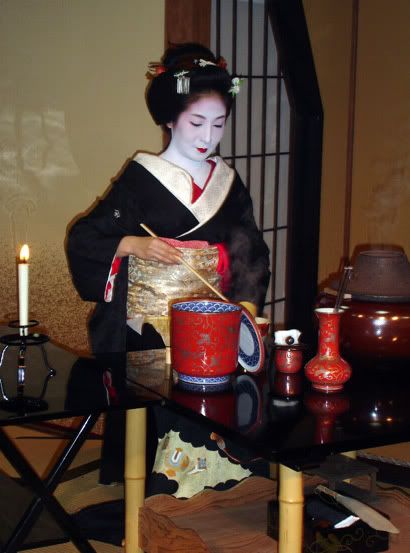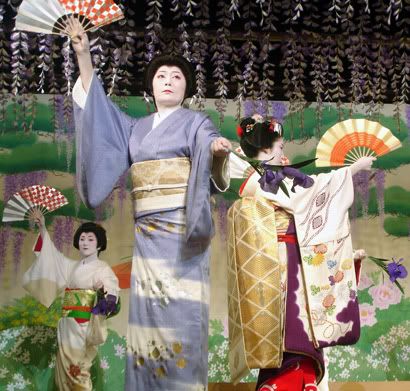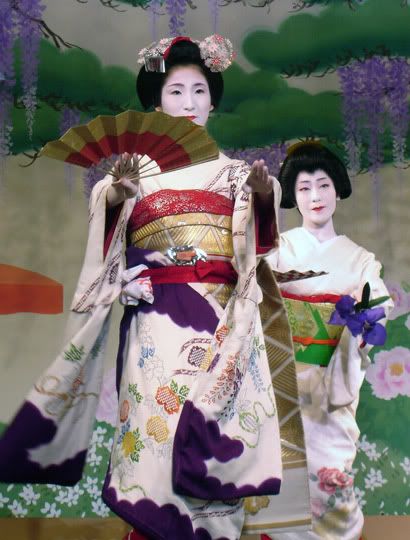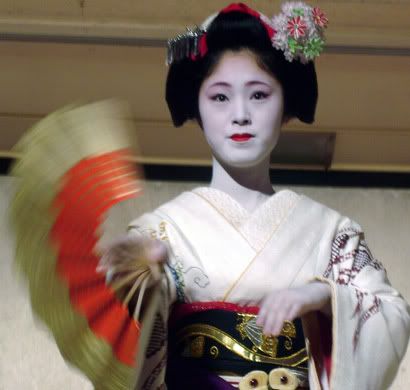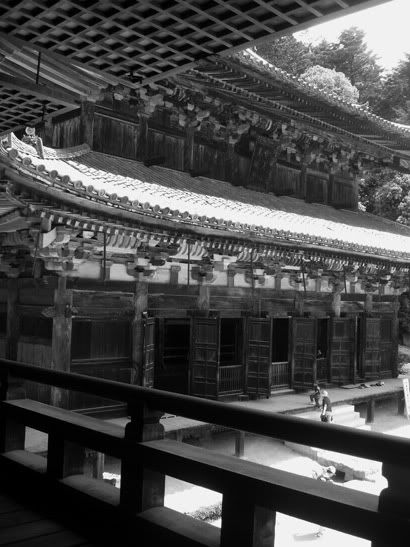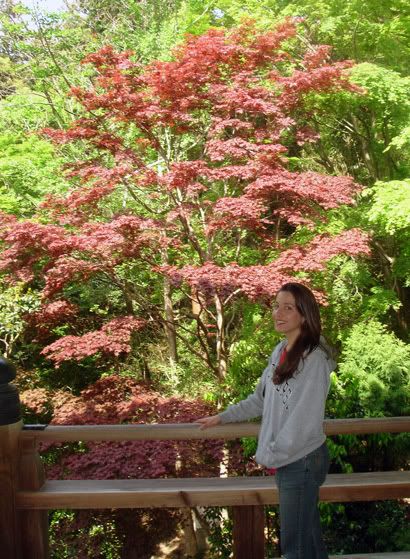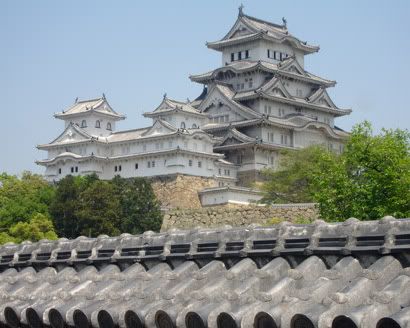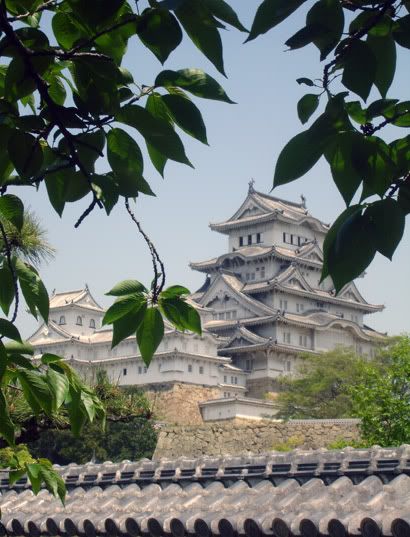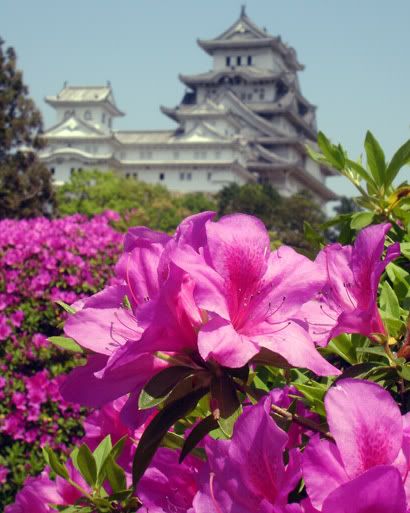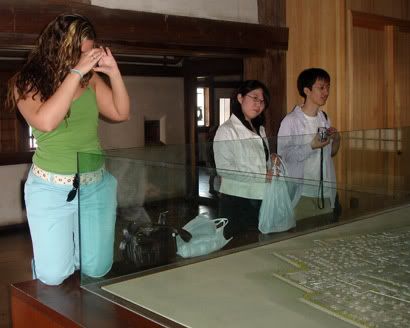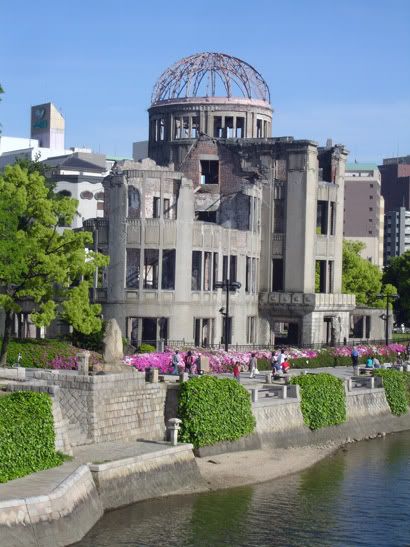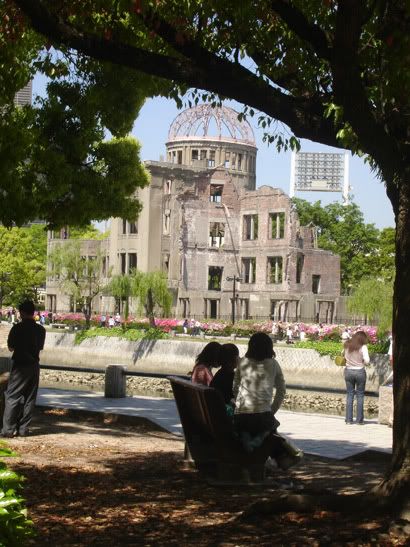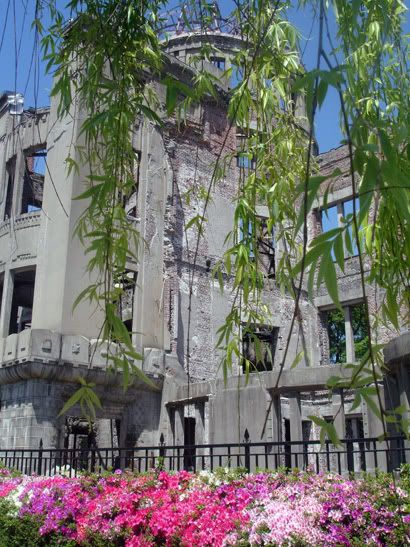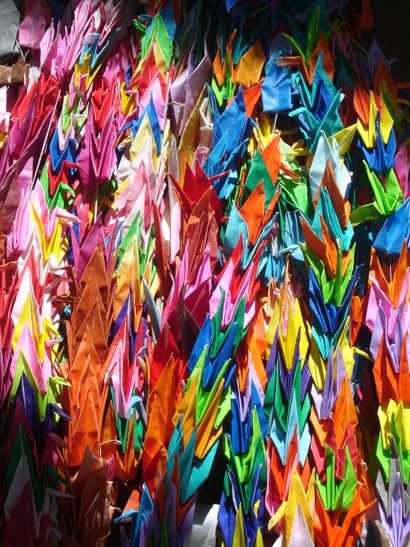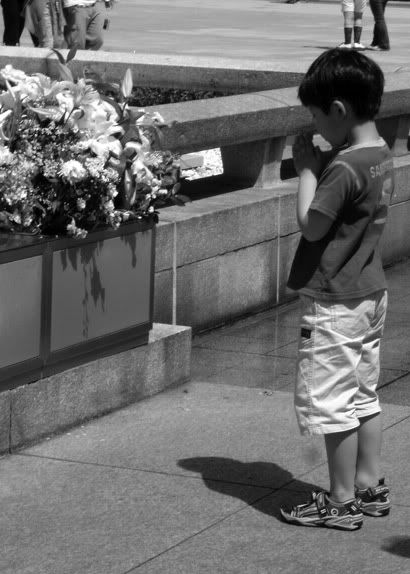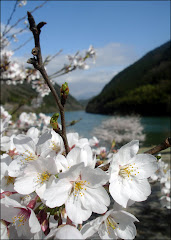After a long day of getting lost in a labyrinth of castle passages, we needed to recoup...And what better place than a secluded temple on the top of a mountain?

Vicki and the view from the top of the mountain. Smaller summits rise up out of the city of Himeji like islands out of the sea, until the city meets the coast. The town itself flows around them like a current, seeking the path of least resistance.
While trying to plan Vicki`s adventures, I came across the name of a relatively obscure temple near Himeji, and figured you can't get a more 'Japanese' experience than staying at a buddhist temple on the top of a mountain! What I didn't know was that it was the same temple where Tom Cruise went to conversate with Kutsumoto in the movie, The Last Samurai!
From Himeji, we hopped on a bus that took us to the foot of the mountain, where we and about 4 other people climbed in a cable car and ventured up the steep, green slope of the mountain, spotted with purple wisteria blossoms. When we got off, I wasn`t very sure how we would find the little temple we were supposed to be staying at, since the top of the mountain was pretty spacious, and all we could see were dusty little paths cutting into dense green forest. As I busted out the map, determined to once and for all overcome my directionally- challenged-ness, this super-hot Japanese kid walked up to me and asked if I had come to stay at the temple."Maybe, I think," was my brilliant response. In my defense, he was hot.
'Um, Ok, this way,' he said, confused. "Let's go." As he turned to lead us away, I looked at Vicki, who was equally stunned by the hotness factor. Silently mouthing such intelligent utterances as 'He is so fine' and giggling like little school girls, we skipped off after him. He led us to his car, and as we drove up a winding, narrow path, I regained my composure and commenced to converse with him in Japanese. He was so excited that I could speak Japanese he didnt stop smiling the entire time. Moral of the story: learning this language does have its benefits!
When we arrived a the temple, a monk showed us to our room. We were the only people staying there, despite the fact that it was Golden Week, the busiest travel seaon of the year!Vicki and I began to freak out about the hottness of above mentioned boy, encouraged by the fact that no one there could not understand a word we were saying. Dinner was simple yet delicous, full of the flavors and textures that define Japanese Cuisine. Of course Vicki is not a huge fan of tofu, fish, miso, soy sauce, seaweed...or any Japanese food for that matter, which means I got all that yummy delicousness for the mere sacrifice of some shrimp tempura, which worked out pretty well (for me atleast)! She did, suprisingly, enjoy the sweet bean treat that came with our matcha, (powdered Japanese green tea, whisked to a frothy delicousness), and sweet steamed Japanese pumpkin.
After dinner we sent out to explore the mountain, hoping to find the not-so-famous temple. It was getting dark, but we followed the dirt path down a steep curve (so steep it was hard not to run) through the shadowy forest. At the bottom was a small, stone bridge where the path crossed a stream before leveling out. Beyond that, all we could see were the sillohettes of the trees, towering over head. But once we crossed the bridge and looked up, this is what we saw.
 Maiden, the main temple of Engyoji.
Maiden, the main temple of Engyoji.
Hidden behind then thin veil of evening (and a few trees trying to keep it a secret), the temple came slowly into view, like a vision materializing before our eyes. In the silence of the deserted mountain top, the deep, steady hum of the temple drum seemed to be calling us up the long flight of stone steps that led up the side of the moutain to the temple. As we ascended, the beating of the drum became stronger, the rythmn more urgent, hurrying us along. When we reached the top we stood mesmorized by the beauty of the architecture, in such perfect harmony with the natural surroundings that it, too, seemed to spring up from the ground along with the trees surrounding it. Without thinking, I rushed towards it, slipping off my shoes and quickly yet quietly tip toeing up the smooth wooden steps of the temple platform. The smell of incense hung in the air so thick I could almost taste it, and not only did the sound of the drum fill my ears and send shivers down my spine, I could feel it pulsating in the cool wood beneath my feet. I secretively slid across the wood, afraid of being discovered, yet unable to tear myself away.
The priest inside began chanting, and I was so enchanted that even though I was afraid that we would get caught, I had to lay down on the deck and take it all in. It was so unbelievable, I wasnt quite sure whether or not it was dream. It seemed like the modern world had been swallowed up by nothingness, and all that was left was the temple, the trees and us three (incuding the monk). It was as if time had ceased to exist, and I wished I could stay in that moment forever. But then the drumming stopped, and the chanting faded away. I heard footsteps inside the temple doors. I jumped up and we ran back across towards the steps where we had shed our shoes and rushed to get them back on. My eyes were fixed on the doors just up the steps, where the footsteps seem to have led, unable to look away. Then the door slowly swung open, and a young monk stepped out with a broom to sweep the deck. He hadnt even noticed us, but I froze. He brushed the broom back and forth a few times, and then slowly turned to look me right in the eyes. He seemed startled. I dont think he is used to seeing anyone up there at that hour. But then he smiled a said Konbanwa, with a small bow. I managed to whisper "Konbanwa", and a quick "Sumimasen" (Im sorry, excuse me) before Vicki and I vanished down the stone steps, our hearts beating louder than the drum that had called us up there in the first place.
By the time we made it back to our little temple, we were exhausted. Before dinner I had talked to the monk at our temple, who told me that if we wanted, he would arrange for us to go to morning service at Maiden. He said that usually people can go to the temple, but they can`t go beyond a certain point (the Biblical equivalent of which would be the Holy of Holies), into the sacred space where the preists commune with God. But by the time we returned from our little adventure, he had spoken with the monk at Maiden, and told us that he would be waiting for us in the morning!
Service started at 6 AM, so half-asleep we hurried back down the little dirt path that led to the temple. When we arrived, the monk once again appeared in the door and called for us to come in. I was so nervous, I began to wonder if I had understood our temple monk correctly, so that when the monk disappeared behind the divide that separted the main hall from the holy place, I hesitated and waited for him to come back to the door and invite us in.
Open doors at Maiden.
As he led us into the dim, candle lit chamber, he asked if we could sit seiza (Japanese style, on our knees and heels) for the 20 or so minutes the ritual would last. I told him that I could, thanks to my gaidai sumi-e training, and that my friend would try, which made him smile. He gestured for us to sit down just behind the small platform where he would be performing the service, and asked me to renew the incense every so often, sprinkling three pinches over a smouldering coal. As he turned to begin, he seemed to disappear into the small, sweet smelling cloud that rose up from the glowing embers. I closed my eyes and took a deep breath as the ring of the monk`s bell cleared my mind and brought me into the moment. Then he began chanting, softly. At first I tried to understand what he was saying, but then I realized he was chanting in Sanskrit. The sound and tone of his voice was so calming, I felt a deep sense of peace just listening to him. Whenever my consiousness drifted away from the moment, the sound of a bell or climatic rythmn would bring me back to where I was.
Before I knew it, it was over. His chanting had stopped, but the final ring of the bell still rang in my ears. I opened my eyes to see him bow down to the ground three times, each time returning to a full upright position. I was suprised to notice that there was no visible image of the buddah to which his worship was directed. Then he turned and came to kneel on the tatami mats before us. 'Do you have any questions?' he asked, but I couldnt think of anything (although now I could think of more than a few! I hate that!)
'You were here last night, right? Did you see everything?' he asked.
'No, we didnt see anything...We just listened to the beat of the drum!' I explained, afraid that there might have been something we werent supposed to see.
'Oh! So you havent seen the other temples? Well then I'll show you around!' he said has he gracefully rose up, waiting for us to follow him.
'Other temples?' I had no idea there were other temples. Akwardly I rose up, trying desperately to ignore the sense of numbness in my legs. We followed him out of the temple and around the back, up a steep, rocky, path. His robes flowing in the breeze with every stride, he seemed to float above the rocky surface. Every step he took was beautiful, even as we hiked up the bumpy path, despite the fact that he was wearing Japanese sandals.
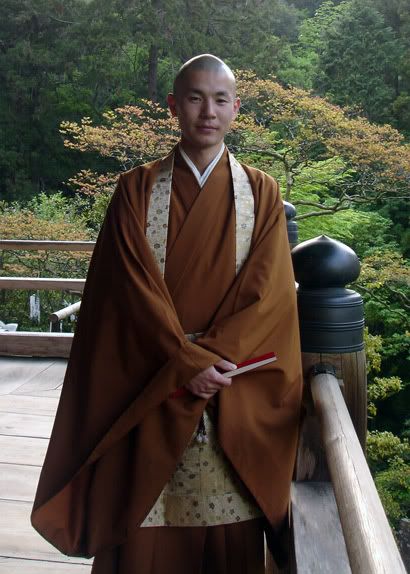
Seijun, the star of the show.
As we talked, I found out that he was born and raised in Osaka. 'Homani?!' ( Really?) I asked him in Osaka dialect. He laughed as we talked about his old hometown and the Tigers, our favorite Japanese Baseball team. He asked me if I had been to Kyoto, and we talked for a long time about how he trained at the San-ju-san-gen-do, one of the few temples I have yet to visit in Kyoto. 'What do you think of this road?' he asked, kicking some dirt with his sandles. 'You don't see anything like this in Kyoto. Everything is paved. ..But I bet you have alot of roads like this up in Gifu!' He said laughing.
I recognized the first temples we came across from the movie. One of the structures was originally used as a living quarters for the hundreds of monks that once lived on the mountain. Now only 15 occasionally make the journey up the mountain, and only one stays there all the time. 'Why do you think there are so few monks these days?' I asked him, curious as to waht his response would be. 'These days nobody needs God, ' he began, 'they think they can do everything for themselves.'
It was still very early, and we were the only people around. 'Oh! Today is a special day!' he exclaimed. ' What time will you leave the mountain?' I told him we were in no rush, and asked why. ' Well, Maiden is always open, because I am there every day. But today is the only day all year that we will open all of these temples! Wait here just a moment, ok?' he said as he glided across the open court towards one of the temples and up the the large wooden doors, which he began to unlatch and swing open.
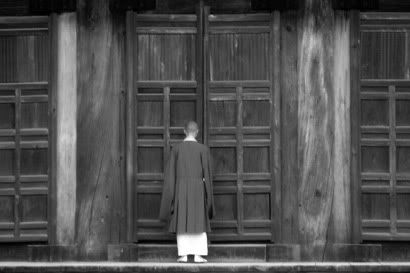 The lone monk of Maiden, born and raised in Osaka and trained at Sanjusangendo, in Kyoto. Definately one of the coolest kids I have ever met!
The lone monk of Maiden, born and raised in Osaka and trained at Sanjusangendo, in Kyoto. Definately one of the coolest kids I have ever met!
These temples, he told us, were about 300-400 years old. The beautiful grain of the wood, weathered and stained by time, could not keep their age a secret, but I cant imagine they ever looked more stunning. As we stepped inside, he began to tell us about the famous 500 year buddah enshrined there. 'Ofcourse you can't see it, or anything...I don't even know if its really there!' he laughed. 'Sometimes i think, I should check it out. Just take a peek and see. But either way, it doesnt really matter if it's there or not. Its all about faith. If you believe its there, thats all that matters.'
View of the home of the 500 year buddah (meaning it is only brought out of hiding once every 500 years), from the old monk`s quarter`s second floor balcony.
 Tomu Cruisu-san (as the Japanese affectionatley call him) and Ken Wantanabe had there daily chats here, strolling along this second story wooden walkway. The longest of its kind in Japan, it wraps around the entire temple.
Tomu Cruisu-san (as the Japanese affectionatley call him) and Ken Wantanabe had there daily chats here, strolling along this second story wooden walkway. The longest of its kind in Japan, it wraps around the entire temple.The last set if temples we came to were the oldest structures on the mountain. It was in this temple court that they shot the famous snow scene in the Last Samurai. As I chatted with the monk, I finally thought to ask him if he had met Tom Cruise. 'Yes, I did.' He replied humbly. 'Was he short? I hear he's pretty short.'
'Not too short,' he said, 'About my size,' he said as he smiled.
'Did he speak Japanese?' I asked.
'Um, yeah, sure.' The he said trying, to be polite.
'Really? Was it weird?' I asked.
'Yeah! It was...It was a little strange!' He laughed.
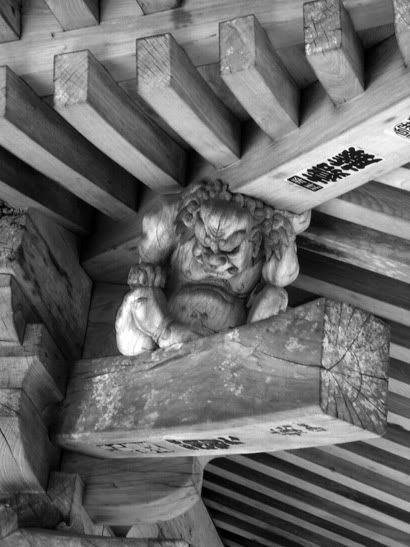 A detail from one of the snow scene temples. This carving is supposed to reperesnt a sumo wrestler, bearing the weight of the roof. There used to be one in each of the four corners, but one is missing. They say he ran away because he couldnt bear it anymore. The stickers are placed there by people hoping it will bring them good luck.
A detail from one of the snow scene temples. This carving is supposed to reperesnt a sumo wrestler, bearing the weight of the roof. There used to be one in each of the four corners, but one is missing. They say he ran away because he couldnt bear it anymore. The stickers are placed there by people hoping it will bring them good luck.
As he led us back towards Maiden, we continued talking about faith. 'Do you know placebos?' he asked, unsure if I understood the medical term in Japanese. 'You mean when doctors give a patient a pill thats not really medicine? Like a sugar pill?' I asked. It was strange that he asked becasue Vicki and I had been talking alot about my mistrust of medicine and belief if natural healing. 'Yes! You know they did a study. Many patients came to the doctor many times, always asking for the newest, best, and most expensive medicine.He finally agreed, giving them placebo instead. Do you know 80% of the people were healed?'
'There was nothing wrong with them in first place.' I said 'It was all in their minds.'
'Well, maybe there was, but it was their faith in the medicine that healed them. Not the medicine itself. Its because they really believed with all their heart that it would make them well. Maybe they made themselves sick, and maybe they healed themselves.'
All to quickly we found ourselves back at the little stone bridge at the foot of Maiden`s steps. 'You said you stayed in Kyoto for 4 years, and you've been here for 3.' I said, sad to let him go. 'How long will you stay?'
'Me? Well, I suppose I'll stay here forever.' he said
'So if I come back...'
'I'll be here waiting.' he said, smiling. He reached into his robes and gave me his meishi (like a buisness card. Meishi are a very important part of Japanese culture. Everyone has them.)
'Thank you so much,' I said, carefully accepting his card. 'I`ll be back, so you better remember me!'
'Ofcourse!' he said. Goodbye!' We both turned to go our separate ways~ him to the temple, us back to the "reality" I hoped had disappeared the night before. As we crossed over the stone bridge, I hesitated and looked back to watch him gracefully ascend up the stone steps, his robes trailing behind him, until he disappeared.
Despite the fact that it is early spring, this maple tree near the Maiden balcony was a brilliant shade of fall.
